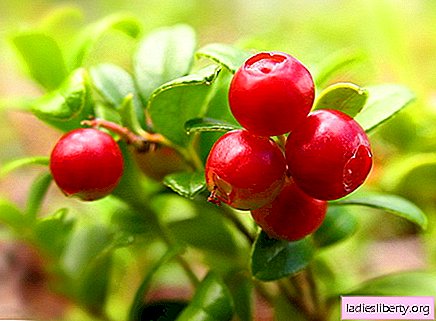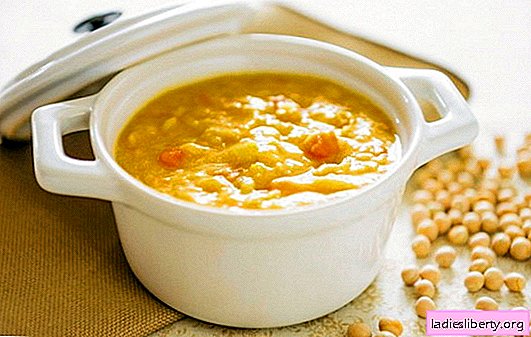
Lingonberry - description
Lingonberry (vitis-idaea) is a shrub of the heather family, with a branched upright stalk that grows up to 25 cm high. This plant is a long-liver, the rhizome has been underground for more than 5 years, growing and not going outside. The length of the rhizome can reach 6 meters, many parts die off, some give rise to 5-6 new bushes. The underground life of lingonberries can last 20 years, a young bush appears in the 6th year of life.
On top, a shiny dark green leathery leaf has an oval (obovate) shape, is slightly bent up, the bottom is lighter in color, the matte leaves on the surface have scattered brown spots that can absorb water. Corolla of a flower in the form of a bell, four cloves are bent outward. Flowers (10-20 pcs.) Collected in short drooping tassels of white or pink.
Lingonberry blooms in May - early June for 15 days, the fruits ripen in August and stay in the snow until the end of winter. The fruit in the form of a spherical bright red shiny berry, has a sweet and sour, slightly bitter tart taste. Eating berries, birds spread seeds to large spaces, thereby contributing to the spread. Lingonberry is a honey collection product for bees.
Lingonberry - types and places of growth
It grows in mixed and dry coniferous forests, moist deciduous forests, in peat marshy areas. It prefers waterlogged soils, but can also grow in dry places, distributed in Europe, the European part of Russia, Siberia, the Far East, the Caucasus, and the tundra. The peoples of many countries have known this berry since antiquity, but the ancient Greek authors did not mention it in their works.
Lingonberry - healing properties
This berry is one of the few that has a huge list of useful properties and has absolutely no contraindications. It has a diuretic effect, it is indicated for urolithiasis, liver diseases. Lingonberries help treat rheumatism, gout, hypoavitaminosis, scurvy. Traditional medicine widely uses the berry for colds and uterine bleeding, chest pain, rheumatism and heart disease. Lingonberry tinctures and decoctions treat bedwetting, cystitis and pyelonephritis, diabetes mellitus. Siberian peoples use lingonberry for many diseases of the gastrointestinal tract, cardiac, colds, salt deposition, and others.
Lingonberry dosage forms
Leaves and fruits are also used as medicinal raw materials. Leaves are harvested in spring, when fruiting has not yet begun. They are plucked without tearing rhizomes. The main value of the leaves is due to the presence of arbutin in them, which upon destruction forms free hydroquinone, acids (gallic, quinic, tartaric), as well as vitamin C. Lingonberry berries contain a large amount of sugars, acids, fatty oils, vitamins A, C, P, etc.
Lingonberry recipes
- In itself, it is valuable to use fresh berries, which, due to their healing properties, can simply save you from scurvy and vitamin deficiency, constipation, colitis and liver disease. Lingonberry juice can lubricate the affected areas with scabies.
- A drink of berries is prepared in the form of tinctures in water for 6 hours. In addition, drinks from cranberry juice are used to increase the general tone of the body, constipation, headache, flu. 50 grams of juice must be diluted with cold boiled water and add honey or sugar. Take 100 grams of the drink 4 times a day before meals.
- Tincture of lingonberry leaves: Pour the leaves with boiling water and leave for 2 hours. Take 1-2 tablespoons before meals.
Lingonberry - interesting facts
- Lingonberry has absolutely no contraindications.
- This is the only berry that can be stored all winter without preservation. It does not sour, does not grow moldy and does not rot, thanks to the benzoic acid included in its composition.
- The first mention of lingonberry came to us from the descriptions of the Flemish botanist Rembert Doduns (Netherlands), and dates back to the 16th century.
- Cultural plantations of this useful berry have been planted since 1960 in the USA, as well as in Germany (40 ha), Sweden, Finland, Poland, Holland. A specialized set of mechanisms for the care of the culture has been developed.
Comments











